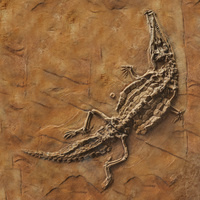Alaskan Palms, Antarctic Dinosaurs and Arctic Crocodiles: The Implications of Past Warm Worlds
Join us for the fourth annual William F. Brace Lecture featuring Dr. Kirk Johnson, Director of the Smithsonian National Museum of Natural History.
With little more than picks and shovels, paleontologists can access ancient organisms, ecosystems, and biomes. This “time travel with a shovel” is a surprisingly effective tool to document and visualize ancient worlds. Forests first appeared on Earth around 380 million years ago and since then their distribution has responded to changing climates and continental configurations. The distribution of extant biomes is controlled by a steep latitudinal temperature gradient that ranges from frigid poles to a hot equatorial zone. One of the most surprising aspects of Earth’s history is the fact that the polar regions, which are the realm of ice and tundra today, have been extensively forested in the past. As today’s climate warms, these past polar ecosystems are becoming increasingly relevant as indicators of future conditions.
Reception to follow in the Ida Green Lounge, Room 54-923
Can't make it? Join the live webcast: http://web.mit.edu/webcast/EAPS/1810/
About the Speaker
Dr. Kirk Johnson is the Sant Director of the Smithsonian National Museum of Natural History. He oversees more than 440 employees and a collection of more than 145 million objects—the largest natural history collection in the world. The Museum hosts more than 7 million visitors annually and, in 2017, its scientists published over 760 scientific research papers and described more than 300 new species.
As a paleontologist who has led expeditions that have resulted in the discovery of more than 1,400 fossil sites, his research focuses on fossil plants and the extinction of the dinosaurs. He is known for his scientific articles, popular books, museum exhibitions, documentaries, and collaborations with artists. In 2010-11, he led the excavation of an ice age site near Snowmass Village, Colorado, that recovered more than 5,400 bones of mammoths, mastodons and other ice age animals. This dig was featured in the NOVA documentary, Ice Age Death Trap, and in Johnson’s book, Digging Snowmastodon, Discovering an Ice Age World in the Colorado Rockies. His recent documentaries include the three-part NOVA series Making North America, which aired on PBS networks in November 2015, and The Great Yellowstone Thaw which premiered on PBS in June 2017. His latest book, Ancient Wyoming, explores the prehistory and geology of the Bighorn Basin.
About the Series
The Brace Lecture is a free, annual event which honors the legacy of "legend in rock physics" and former EAPS Department Head Bill Brace, who passed away in 2012. The William F Brace Lecture is an annual all-department event at which a distinguished visitor from outside MIT is invited to speak on a subject of contemporary interest in earth, atmospheric or planetary science.
For more information please contact: Brandon Milardo, bmilardo@mit.edu.



